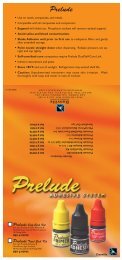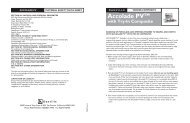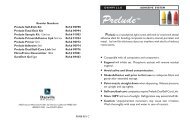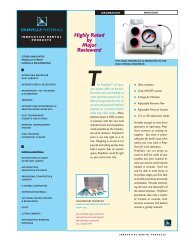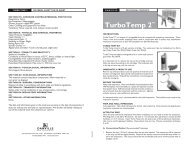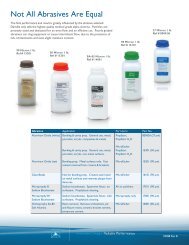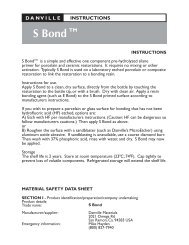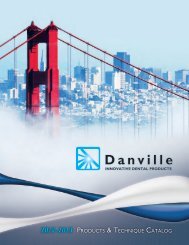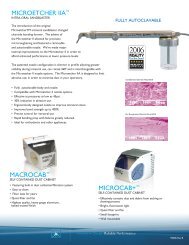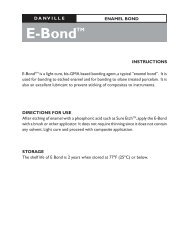First Half - MSDS.pdf - Danville Materials
First Half - MSDS.pdf - Danville Materials
First Half - MSDS.pdf - Danville Materials
Create successful ePaper yourself
Turn your PDF publications into a flip-book with our unique Google optimized e-Paper software.
D A N V I L L E<br />
<strong>First</strong> <strong>Half</strong><br />
IMPRESSION MATERIAL<br />
StarVPS<br />
TM<br />
INSTRUCTIONS<br />
<strong>First</strong> <strong>Half</strong> is a super hydrophilic, fast setting vinyl polysiloxane (sometimes called addition silicone)<br />
impression system. The setting time is slower than <strong>Danville</strong>’s super-fast <strong>First</strong> Quarter materials but<br />
faster than the Star VPS impression materials.<br />
<strong>First</strong> <strong>Half</strong> is available in two viscosities, a Light Body and a Heavy Body. These materials are intended<br />
primarily for the dual viscosity impression technique. The Light Body may also be used for the putty/<br />
wash technique using <strong>Danville</strong>’s Star VPS putty or a compatible vinyl polysiloxaine putty. The black<br />
color of <strong>First</strong> <strong>Half</strong> Light enhances margin readability and contrasts with virtually all other material<br />
impression material colors, assuring visibility.<br />
<strong>First</strong> <strong>Half</strong> is odorless and tasteless. It is immersible in glutaraldehyde solutions and other disinfectants.<br />
CARTRIDGE PREPARATION<br />
1. Insert cartridge into an appropriate 1:1 mixing gun, remove twist-off cap, and extrude a small amount<br />
of material until even flow from both barrels is seen. Discard the dispensed material and wipe the<br />
cartridge end clean with tissue, avoiding cross contamination of the barrels.<br />
2. Attach an auto mix tip of desired size. The material is now ready for use.<br />
3. After use, do not remove the automix tip. The used tip serves as a seal until removed for the next use.<br />
CLOSED BITE IMPRESSIONS<br />
1. Select an appropriate tray such as Premier Triple Tray. (Technique Tip: It is best to avoid metal trays<br />
“bite trays” if a second pour is made in the laboratory. Metal trays tend to distort when the lab pries the<br />
first cast out of the impression, precluding an accurate second pour.)<br />
2. The impression should be made by using both the Heavy Body and Light Body simultaneously.<br />
Generally one person loads the tray with the Heavy Body while another person syringes Light Body<br />
onto the teeth. Then the tray is seated over the Light Body and the patient closes onto occlusion.<br />
Sometimes it is helpful to blow air on the Light Body to get it to flow onto the teeth, prior to<br />
seating the tray. To avoid distortion, it is important to fully seat the impression before any elasticity<br />
develops in the impression materials. (Technique Tip: Putty should not be used in place of the Heavy<br />
body since it tends to result in elastic distortion.)<br />
3. Under normal conditions, the patient may open and the impression can be retrieved after 2 min.<br />
15 sec. from beginning the mix. Since setting time depends strongly on the temperature of the<br />
impression material, it is wise to check the setting of some extra material left at room temperature<br />
before retrieving the impression. (Generally setting in the mouth is faster due to higher temperature,<br />
creating a margin of safety.)<br />
4. Water wash and dry the impression after removal from the mouth.<br />
Note: <strong>First</strong> <strong>Half</strong> Light is often used with Stiff Bite in the H&H technique as described by Dr. Jeff Hoos.<br />
Contact <strong>Danville</strong> for further details.
FIRST HALF<br />
IMPRESSION MATERIAL<br />
SEPARATE FULL ARCH “PUTTY/WASH” IMPRESSIONS<br />
(use Light Body and Star VPS Putty)<br />
Creating the most accurate impressions using putty requires a putty pre-polymerization technique.<br />
The putty is allowed to fully polymerize (and fully distort) before using the wash material to provide<br />
accuracy and detail. <strong>First</strong> <strong>Half</strong> Light Body is ideal for the wash, especially with the <strong>Danville</strong> needle tip<br />
attached to the automix tip.<br />
1. Before preparing teeth, make a putty impression in a retentive tray such as a rim lock or a perforated<br />
tray. Prevention of interproximal tags and space for the wash is easily created by applying Reynolds<br />
Wrap or a section of a sandwich bag to the putty before seating in the mouth. Do not remove the<br />
plastic wrap until ready for the wash. (Technique Tip: some brands of plastic wrap will interfere with<br />
the polymerization of the putty, leaving a very obvious liquid putty surface. A test is advised before use.)<br />
2. For the final impression, remove the plastic wrap and apply Light Body to the putty surface. Optionally<br />
dispense Light Body onto the clean and dry prepared teeth. Seat the impression tray.<br />
3. Under normal conditions, the patient may open and the impression can be retrieved after 2 min.<br />
15 sec. from beginning the mix. Since setting time depends strongly on the temperature of the<br />
impression material, it is wise to check the setting of some extra material left at room temperature<br />
before retrieving the impression. (Generally setting in the mouth is faster due to higher temperature,<br />
creating a safety margin.)<br />
4. Water wash and dry the impression after removal from the mouth.<br />
CUSTOM TRAY TECHNIQUE<br />
The custom tray is usually made of methyl methacrylate or light-polymerizing material such as Triad.<br />
<strong>First</strong> <strong>Half</strong> Light is ideal as a wash material. A vinyl polysiloxane adhesive must be applied to the tray<br />
and dried before the wash is placed. Follow the adhesive manufacturers instructions. Light Body is<br />
applied as for the putty/wash technique.<br />
ADDITIONAL NOTES:<br />
<strong>First</strong> <strong>Half</strong> materials should be brought to room temperature prior to use. Exposure to prolonged<br />
temperatures above 77 O F can be damaging. Store at room temperature.<br />
<strong>First</strong> <strong>Half</strong> materials are compatible with all other vinyl polysiloxane materials.<br />
Powder from gloves can impair set. Sample test is suggested. Keep putty jars closed when not in use.<br />
High viscosity materials used alone are not suitable for detailed impressions.<br />
Light Body Black impression materials used alone can flex excessively and may result in distortion.<br />
Procedures and techniques prepared courtesy of Raymond Bertolotti, DDS, PhD. For further<br />
information, please contact 5th Quarter Seminars at (510) 483-2411, FAX (510) 652-8729.<br />
www.adhesion.com<br />
90746 REV B
FIRST HALF<br />
MATERIAL SAFETY DATA SHEET<br />
MATERIAL SAFETY DATA<br />
SECTION 1 - PRODUCT IDENTIFICATION<br />
Company Name: <strong>Danville</strong> <strong>Materials</strong>, Inc.<br />
3420 Fostoria Way, Ate A-200<br />
San Ramon, CA 94583<br />
Phone (800) 827-7940<br />
Fax: (925) 973-0764<br />
Prepared: August 22, 2006<br />
SECTION II - INGREDIENTS AND HAZARDS<br />
Chemical Name: Mixture of Polydimethylsiloxane, Silica and Paraffin<br />
Chemical Family: Silicon<br />
Hazard Data: No known hazardous components.<br />
SECTION III - PHYSICAL DATA<br />
Boiling Point: N/A<br />
Vapor Pressure: N/A<br />
Vapor Density: N/A<br />
Solubility in Water: Insoluble<br />
Percent Volatile: 2%<br />
Evaporation Rate: N/A<br />
SECTION IV - FIRE AND EXPLOSION DATA<br />
Flash point: 485 O F (252 O C) closed cup - DIN 51755 Extinguishing Media: Water, CO 2<br />
Firefighters should wear full protective clothing including a self-contained breathing apparatus.<br />
During a fire, irritating and/or toxic gases and aerosols may be present from the decomposition/<br />
combustion products.<br />
SECTION V - REACTIVITY DATA<br />
Stability: Stable Conditions to Avoid: N/A<br />
Incompatibility: N/A<br />
Hazardous Decomposition: N/A<br />
Hazardous Polymerization: None<br />
SECTION VI - HEALTH HAZARD INFORMATION TLV (SEE SEC. II)<br />
Threshold Limit Value: N/A<br />
Effects of Over Exposure: N/A<br />
Eye Contact: Flush eyes with large amounts of water, consult a physician.<br />
Skin Contact: Wash thoroughly with soap and water.<br />
Ingestion: Consult a physician immediately.<br />
SECTION VII - SPILL OR LEAK PROCEDURES<br />
Steps to be Taken in Case of Spill: Cover with an absorbent material such as sand or sawdust, scoop<br />
up and place in appropriately marked container.<br />
Waste Disposal Method: Waste material may be incinerated under conditions according to federal,<br />
state, and local environmental control regulations.<br />
SECTION VIII - SPECIAL PROTECTION INFORMATION<br />
Respiratory Protection: None required<br />
Protective Gloves: Rubber, VPS, Nitrile<br />
Eye Protection: Protective goggles<br />
Other: Rubber apron<br />
SECTION IX - SPECIAL PRECAUTIONS<br />
N/A
D A N V I L L E<br />
M A T E R I A L S<br />
3420 FOSTORIA WAY STE. A-200 SAN RAMON, CALIFORNIA 94583 USA<br />
PHONE 800/827-7940 FAX 925/973-0764<br />
90746 REV B




